Landed or not landed on the asteroid? Collected samples or not collected samples?
Since December 9, contact with the spacecraft has been cut off, and the chances of it being restored until the close of the launch window towards Earth (until the end of December) are slim
16.12.2005
By: Avi Blizovsky
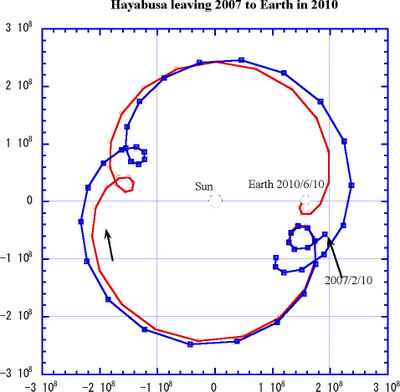
Diagram of Yabusa's return route to Earth, as planned (2007)
The Japanese spacecraft Yabusa is currently undergoing a series of operations in an attempt to renew its communications with ground stations on Earth. The spacecraft experienced sudden disturbances in its torque, due to a fuel leak that occurred earlier and communication with it has been lost since December 9. The project team is optimistic about the possibility of restoring communications soon. However, the delay hurts the chances of the spacecraft returning to Earth in June 2007. In the meantime, the orbits of the spacecraft and the Earth are moving further apart and it will be necessary to wait three more years until the spacecraft's return - to June 2010.
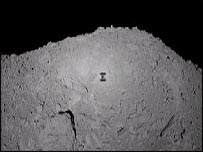 On December 8, the ground control personnel noticed that the range measuring devices had moved and as a result the control signal was weakened. The measurements and the intensity changed slowly and apparently they are due to the gas leak that happened at the end of November. On November 26-27, the Japanese scientists fired the engine. On the 29th the spacecraft landed on the asteroid. The media also returned and it turned out that the ignition was carried out as planned.
On December 8, the ground control personnel noticed that the range measuring devices had moved and as a result the control signal was weakened. The measurements and the intensity changed slowly and apparently they are due to the gas leak that happened at the end of November. On November 26-27, the Japanese scientists fired the engine. On the 29th the spacecraft landed on the asteroid. The media also returned and it turned out that the ignition was carried out as planned.
On December 8, the Japanese tried to renew the propulsion of the spacecraft with the chemical engine and the spacecraft went into a slow rotation for six minutes. Since the beginning of December, the Japanese have been operating the spacecraft's Zenon engine in emergency mode, but this attempt was not strong enough for the spacecraft to avoid further malfunctions. Now it is possible that the spacecraft is in a conical motion and that is why the spacecraft is not responding to the commands sent to it from the control center.
As mentioned, contact with the spacecraft has been lost since December 9. Analyzes of the position of the spacecraft in relation to the Sun and the Earth show that it may be possible to resume contact within a few months. In light of all these malfunctions, the spaceship is lost and loses its exit window to Earth, and if the connection is not renewed accordingly, the Japanese will be forced to place it in orbit around the Sun and depart from it to Earth towards 2010.
The operating mode of the spacecraft will go from normal mode to rescue mode for several months to a year. A long-term forecast indicates a high probability that it will be possible to renew the connection using the powerful antenna of the Ushoda Space Center. It is estimated that the amount of Xenon gas on the spacecraft is sufficient for its return to Earth.
Doubts about the success of Yabusa to collect soil samples
9/12/2005
The Japanese spacecraft that landed twice on the asteroid Itokawa failed to collect the soil samples, and this casts doubt on the question of declaring the success of the mission, which was mainly intended to return soil samples to Earth. This is what senior officials at the Japanese space agency JAXA said on Thursday.
Data from the spacecraft, which is hovering a few kilometers from the asteroid, does not indicate that the spacecraft fired a metal projectile at the surface of the asteroid during the landing as previously believed.
According to Seiji Aoyama, from the Japanese Space Agency: Now we won't know until Yabusa reaches Earth, and we leave the question open. Oyama said. On November 26, JAXA announced that the spacecraft appeared to have touched the ground, fired the projectile to cause dust to rise to the collection devices on board and lifted off again to transmit the data to mission controllers.
The landing on November 26 was the second in about a week after a first attempt failed, and the mornings had no idea that the spacecraft had landed until several days later, long after it had left the asteroid.
Still, there is a faint possibility that the spacecraft's own impact with the ground released enough particles that could be collected. Oyama says.
The Yabusa was launched in 2003 and was supposed to land in the Australian desert in June 2007, but a technical glitch could cause its arrival to be delayed. The malfunction is due to damage to its propeller after the second takeoff from Itokawa, which caused the Jacada to shut down the engine. The agency has until December 10 to fix the problem. On this date the Yabosa must begin its journey to Earth. Beyond this date, it will be necessary to wait two more years because the spacecraft's orbit around the sun, adjacent to the asteroid's orbit, takes about two years.
The Japanese believe that Yabusa collected samples. Soon she will make her way back to Earth
Only in 2007 when the spacecraft lands in the deserts of Australia will the scientists know for sure if the mission was successful
26.11.2005
By: Avi Blizovsky
The spacecraft was able to photograph its shadow on the asteroid10: 00 Update
The Japanese space agency believes that Yabusa has become the first spacecraft to collect soil samples from the face of an asteroid. However, they will only be sure of this when the Yabusa return to Earth in 2007.
The length of the asteroid Itukuwa is 690 meters and its width is about 300 meters. Its gravity is 1/100,000 that of Earth. The asteroid is currently 290 million kilometers from Earth.
09: 45 Update
The Japanese space agency JAXA believes that the Yabusa spacecraft has successfully landed and collected soil samples from the asteroid Itokuwa.
Tonight, the spacecraft successfully landed on the asteroid and launched a small metal ball so that its impact would cause dust to be released from the surface so that it could be collected, the agency said. However, the scientists will be sure if indeed the spacecraft took the samples when it returns to Earth in 2007.
Malfunction in the propeller of the Yabusa spaceship
09:30
The Japanese spacecraft "Hyabusa", which landed early in the morning on the asteroid "Itokawa", started moving up and down apparently due to problems with the propeller. The Japanese space agency JAXA says that the spacecraft, which is now hovering about 5 kilometers from the surface of the asteroid, will be transferred to a 'safe mode' until the malfunction is checked. This morning the Japanese Space Agency said that the spacecraft managed to land, but for several hours there was no sign of whether it was also able to collect the samples. In the previous attempt, on Sunday this week, the spacecraft stayed on the asteroid's ground for half an hour, failed to complete its mission and took off.
The Yabusa landed on the asteroid Itokuwa, but it is not clear if it was able to take the soil samples
שבת, 26/11/2005 08:00
The Yabusa spacecraft successfully landed for the second time on the asteroid Itukuwa. This is what the Japanese Space Agency said tonight. However, it is not yet clear whether she was able to take soil samples.
As mentioned, this is the second landing attempt after the spacecraft landed on the asteroid on Sunday this week, stayed on its surface for about half an hour and took off without collecting samples.
Yabusa: Landing attempt Monday night (between Friday and Saturday) at midnight
25/11/2005 שעה 19:30
Tonight (between Friday and Saturday) around midnight Israel time (Saturday, seven in the morning Japan time, 22:00 Friday GMT) the Yabusa spacecraft is supposed to land again on the spinning asteroid Itoqua. As a reminder, on Saturday the spacecraft landed on the asteroid but was unable to release the soil sample collection equipment (see the rest of the news)
The target marker - a device the size of a can that includes a separate radio transmitter from the yabusa a few hours before the landing attempt, from a height of 32 meters above the surface of the asteroid
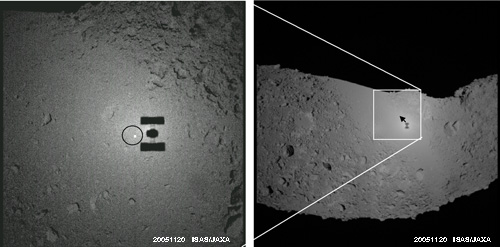
The Yabusa landed on the asteroid but was unable to dig up soil samples from its soil
24/11/2005
The Japanese spacecraft Yabusa landed safely on the asteroid it was sent to despite the initial failure announcement made by the Japanese on Sunday. However, it seems that it failed to release the soil collection equipment to the surface of the asteroid Itoqua.
The Japanese spacecraft is on a mission to collect and return soil samples from Itokawa to Earth in the summer of 2007.
The flight controllers lost contact with the spacecraft after maneuvering a few meters above the space rock. However, the data confirmed that the Yabusa landed on Itokawa on Sunday for half an hour. The Japanese space agency said.
As recalled on Sunday, agency spokesman Toshihisa Hirogoshi said that "the Hayabusa came very close but did not manage to land." He added that the reasons for the malfunction are unknown.
However, in an update provided on Wednesday, the agency announced that the spacecraft managed to land on the asteroid, which is 290 million km from Earth, for thirty minutes. This is the first landing of a Japanese spacecraft on another object in the solar system. the agency said.
The Japanese space agency JAXA said that it will decide today (Thursday) whether to make a second attempt to land the Yabusa tomorrow, Friday November 25.
Although the body of the spacecraft suffered major damages some of the sensors still need to be tested. the agency said.
The Yabusa spaceship did not land on the asteroid and ran away about XNUMX km from it. Another attempt on Friday
20.11.2005
By: Avi Blizovsky
Update time 16:00
Contact with the spacecraft was restored, but it failed to land automatically as it was supposed to do after it lost contact with it in the morning. It is apparently within 100 kilometers of the asteroid. The Japanese plan to make another landing attempt on Friday.
Contact was lost with the Japanese spacecraft Yabusa, seconds before it landed on an asteroid
20/11/2005 שעה 10:00
A Japanese research spacecraft came within a few meters of the surface of the asteroid Itokawa today (Sunday), but lost contact, and it is unclear if it landed successfully in order to collect samples from the surface of the asteroid. This is what the Japanese Space Agency said.
According to the plan, the spacecraft was supposed to make a crash landing on the asteroid, collect a soil sample and take off back to Earth.
The Yabusa reached a height of about 120 meters above the Itokawa asteroid, then launched a telemetry device the size and shape of a football down, which would mark the target site and then descended another 50 meters. According to the Japanese Space Agency, at this point contact with the spacecraft was lost for three hours. The spacecraft was put into self-control mode and the scientists are analyzing the data it collected. It was only reported that after that the spaceship suffered a series of malfunctions.
A general repetition of this landing was stopped about a month ago due to a problem locating the landing point and a small robot sent for a test landing was lost. Earlier malfunctions disabled two of its three gyroscopes, but these were later repaired.
We will update as soon as there is new data.
The probe sent by the Japanese spacecraft to practice landing on the asteroid was lost in space
The mother spacecraft will still try to land on November 19 or 25
15/11/2005
The Japanese space agency's mission to collect soil samples from the asteroid's surface and return them to Earth suffered a serious setback when a tiny lander was lost in space trying to land on the asteroid as part of a return to final landing. Despite the loss of the probe, the mother spacecraft itself is scheduled to land on November 19 or 25, depending on the considerations of the Japanese Space Agency.
The Yabosa spacecraft launched a probe named Minerva - the surface explorer robot - to the surface of the asteroid, but the Japanese space agency said that it appears that the probe has begun to drift out of the asteroid's surface. Minerva is expected to land and bounce around the asteroid to collect data using three color cameras. "Unfortunately, it seems that Minerva did not recognize the surface," the agency said in a statement.
Minerva was still in radio contact with the Yabusa on Saturday, and flight controllers were trying to learn more details about her condition and location. Senior officials of the Japanese space agency fear that the broadcasts will not be resumed. Nevertheless, Junichiro Kawaguchi, a senior official at the Japanese space agency, said that the probe nevertheless collected some data on the asteroid that will help better landing the mother spacecraft.
The attempt to land the Japanese spacecraft Yabosa on an asteroid: on November 19
On November 4, a Japanese spacecraft landing on an asteroid was postponed at the last minute
13.11.2005
By: Avi Blizovsky
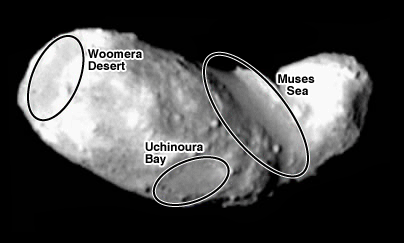
The Japanese spacecraft Yabusa is on a trajectory that will bring the robot that left it to land on the asteroid Itokawa on November 19.
In an attempt made on November 9, the spacecraft reached a height of 70 meters from the asteroid during an approach attempt in which the functioning of the spacecraft's navigation and guidance devices was proven. On November 4, the planned landing on an asteroid was postponed. The spacecraft reached a distance of hundreds of meters from the rocky surface of the asteroid when it was decided to cancel the operation. The website of the Japanese Space Agency states that the landing was canceled when an "anomalous signal" was received from the spacecraft.
The Yabusa spacecraft was supposed to send a robotic lander to the surface of the asteroid Atokwa, about a week ago, and began attempts to collect samples of space dust. During the return approach, the spacecraft came within 640 meters of the surface when it lost its ability to identify the target site on the surface, said Dr. Stephen Lowry, an astronomer and asteroid expert at Queen's University in Belfast. According to him, he hopes to make an attempt to throw the robot Minerva to the asteroid in the coming weeks. It is a 10-centimeter-tall robot designed to hover over the surface of the asteroid, measure the tantropora on its surface and take pictures. And this is the first time that an attempt has been made to make a soft landing of instruments on an asteroid, and the planetary astronomers are already eager to see high-resolution images from the surface when the vehicle wanders there. Dr. Lowry said. "The data that will be collected will help to understand more about the nature of these bodies, which are the remains of the formation period of our solar system."
Despite the loss of two out of three gyroscopes that are supposed to stabilize it without the need to use fuel, it still has enough fuel to land and return to Earth. This is because the mission managers changed the parameters of the flight to save fuel. The spacecraft is scheduled to begin its journey back to Earth in December and arrive in June 2007. If successful, it will be the first spacecraft to return samples from an asteroid.
The Japanese spacecraft Yabusa photographed the comet on which it will land
The image shows hilly areas and flat areas on the asteroid
17.9.2005
By: Avi Blizovsky
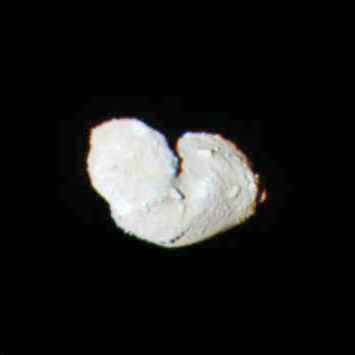
The Japanese Yabusa spacecraft has reached a distance of only 20 kilometers from the asteroid it has been traveling to for over two years.
The spacecraft will collect samples from the surface of the asteroid Itoqua and return them to Earth for testing.
The scientists of the mission hope that the findings will shed light on the question of how these mysterious bodies in the solar system were formed and developed.
The Yabusa used an efficient ion engine to reach its goal. The spacecraft will now hover around the asteroid, collecting data on it from a distance until it is decided that it is safe to land. You can read about the detailed process in the article attached below.
The plan is to land the spacecraft on the asteroid, collect the samples from the surface and return them to Earth. The spacecraft will stay in the vicinity of the asteroid for about two months, and after taking the sample it will return to Earth. The Yabusa is scheduled to fall to Earth in the summer of 2007.
A new image taken by the spacecraft recently showed contrasts between 12 hilly areas and smooth terrain on the asteroid. Scientists at the Japan Institute of Space Science and Astronautics (Isas), which is monitoring the mission, said studying the asteroid's surface trajectory could lead to a better understanding of how the asteroid formed.
So far, examples have only been brought from the moon. An attempt to bring interstellar dust to Earth (Stardust) failed when the spacecraft crashed on its return to Earth.
The asteroid is named after the late Dr. Heido Itokawa, who is considered one of the fathers of the Japanese space program.
The Japanese spacecraft Yabusa will reach the comet in September, take a sample from its surface and return to Earth
29.8.2005
By: Avi Blizovsky
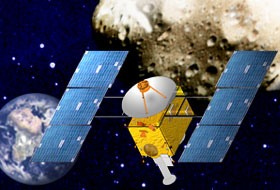 The Japanese Space Agency's Yabusa spacecraft (also known as MUSES-C) will investigate the asteroid Itokawa from the series known as near-Earth asteroids. Through the mission, the Institute for Space and Astronautical Sciences (ISAS) will test the technologies that will allow bringing back to Earth a sample from the surface of an asteroid. However small these samples may be, they will allow a detailed analysis of these particles in the laboratory. The scientific value of the samples is enormous.
The Japanese Space Agency's Yabusa spacecraft (also known as MUSES-C) will investigate the asteroid Itokawa from the series known as near-Earth asteroids. Through the mission, the Institute for Space and Astronautical Sciences (ISAS) will test the technologies that will allow bringing back to Earth a sample from the surface of an asteroid. However small these samples may be, they will allow a detailed analysis of these particles in the laboratory. The scientific value of the samples is enormous.
There are several sample return missions in various stages of preparation around the world. While these missions require a large-scale rocket, Japan has explored the possibility of launching a mission that would require a small spacecraft with the goal of discovering another accessible asteroid and developing an efficient electric propulsion system for the spacecraft.
The main task of the MUSES-C mission is to make sure that the technology is capable of carrying out the goal - flying to an asteroid and returning a sample from it. "We are convinced that this mission will provide us with the technical and technological data that will allow us to promote the ability to return samples in the future.
For more than two and three months after its launch in May 2003, the Yabusa spacecraft traveled a long way from Earth using its gravity on a May 2004 flyby.
It will be the first low-thrust spacecraft to rendezvous with asteroid Itokawa (1998SF36) next month.
Meanwhile, the Yabusa spacecraft imaged its target comet at the end of July, on August 8-9 and on August 12. A total of 24 photos. The integrated navigation system that includes both radio and optical measurement systems uses these images to guide the spacecraft toward final approach to the object.
The navigation system, which operates at a slow rate due to the use of an ion engine, successfully performed its first ignition. During the coming weeks, the comet will also be photographed using a high-resolution camera.
The spacecraft carries three reaction wheels. In one of them, the one responsible for rotation on the X axis, a malfunction occurred on July 31. However, the spacecraft is also equipped with software to repair a double-reaction wheel and it has been activated. The spacecraft resumed its stable flight and is functioning normally.
The spacecraft team is convinced that it will achieve the avenue of scientific observations, including taking the expected sample during the connection phase.
The spacecraft was found on August 12, the day the news was last updated on the Japanese Space Agency's website, at a distance of 35 km from its destination (currently the distance is less than 9,000 km) and at a speed of 38 meters per second. This is incredible speed that will allow for a low thrust encounter never before attempted. The spacecraft will turn off its ion engine at a distance of 3,500 km from the object and continue at the residual speed to reach a speed of 10 meters per second. The deceleration will be done through a reaction control system. In mid-September, the spacecraft will reach a relative distance of 20 kilometers from the asteroid.
After that, the spacecraft will continue to accompany the comet for the time it takes to study the area and find the landing site. Then the spacecraft will begin to approach the asteroid.
First, it will perform measurements of the relative distance and height from the surface using two devices designed for this purpose. During the approach, the spacecraft will adjust its engines independently and it will transmit images to Earth during this entire process. Although the control center on Earth will not be able to maneuver the spacecraft because it will be 10 light minutes away, it will be able to send a command if the controllers detect danger but no more. Most of the important decisions must be made by the spacecraft itself.
At an altitude of 100 meters, the spacecraft will drop a target marker onto the asteroid's ground. The marker, with a diameter of about 10 centimeters, will shine on the surface of the asteroid and will return the flash beam from the spacecraft according to which it will also land. From this point on, a device known as LRF will be activated that measures the distance between the spacecraft and the surface, as well as the
The slope of the surface using radial projection of multiple rays. Another device, FBS will be used to detect a crash hazard on the surface.
After approaching the surface of the asteroid and before the final touch down with the ground, the spacecraft will stop its engines and fall into free fall. This is to prevent the jets from contaminating the surface of the asteroid by getting too close to it. From this point, the engines will remain in the closed position until the sampling task is completed. After the descent in free fall, the sampling will begin immediately. An excavator will then remove the sample and put it into the spacecraft. Immediately after sampling, the spacecraft will activate its engines and immediately take off, resume hovering at a height of 100 meters and wait for the next command from Earth.
Sampling techniques
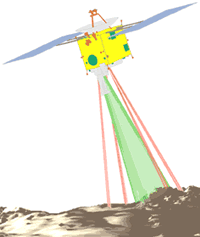 How will the samples be collected? Compared to the Moon's gravity, less than one-sixth that of Earth, the gravity on the asteroid's surface is minuscule, less than one hundred thousandths of Earth's. If an excavator or any other tool for digging that is secured by a strong anchor to the surface is not used, the spacecraft may be pushed away before the excavator digs a hole. Apart from this, there is another factor that makes it difficult to take the sample, and that is that we do not know what the asteroid is really made of. After all, that's why the spaceship gets there in the first place.
How will the samples be collected? Compared to the Moon's gravity, less than one-sixth that of Earth, the gravity on the asteroid's surface is minuscule, less than one hundred thousandths of Earth's. If an excavator or any other tool for digging that is secured by a strong anchor to the surface is not used, the spacecraft may be pushed away before the excavator digs a hole. Apart from this, there is another factor that makes it difficult to take the sample, and that is that we do not know what the asteroid is really made of. After all, that's why the spaceship gets there in the first place.
It turns out that the Japanese have not yet decided on which method the excavation will be carried out, apparently the instruments in the spacecraft are capable of a variety of options depending on the conditions on the ground.
Return to Earth
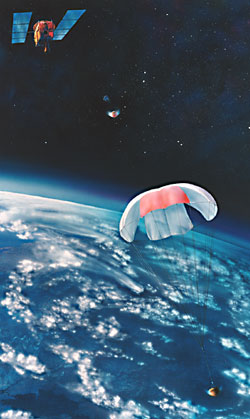 In the final phase of the mission, a small capsule that will contain the asteroid sample will enter the Earth's atmosphere in mid-2007 at a speed of 12 kilometers per second. The maximum heating rate of the capsule back into the atmosphere is tens of times higher than that of the space shuttle and several times that of the Apollo return chambers. The material from which the heat shield is made was developed with the newest technologies. After the spacecraft is slowed by the atmosphere, it will release parachutes for a soft landing. The capsule will be located according to the radio location that will be transmitted, and thus it will be possible to extract it.
In the final phase of the mission, a small capsule that will contain the asteroid sample will enter the Earth's atmosphere in mid-2007 at a speed of 12 kilometers per second. The maximum heating rate of the capsule back into the atmosphere is tens of times higher than that of the space shuttle and several times that of the Apollo return chambers. The material from which the heat shield is made was developed with the newest technologies. After the spacecraft is slowed by the atmosphere, it will release parachutes for a soft landing. The capsule will be located according to the radio location that will be transmitted, and thus it will be possible to extract it.
